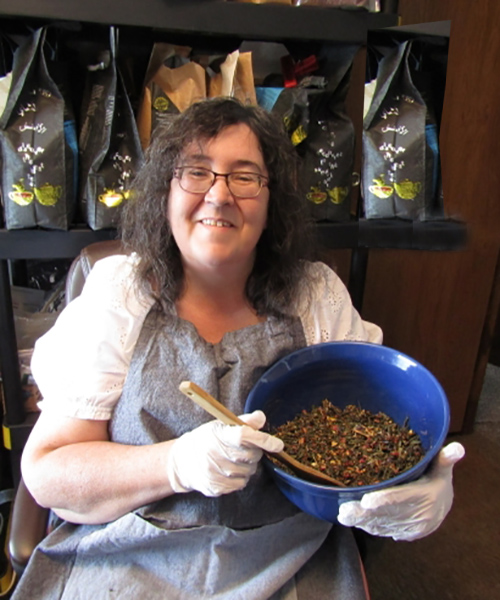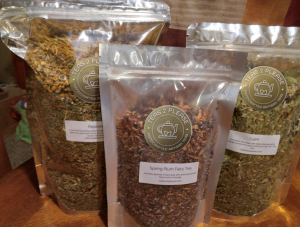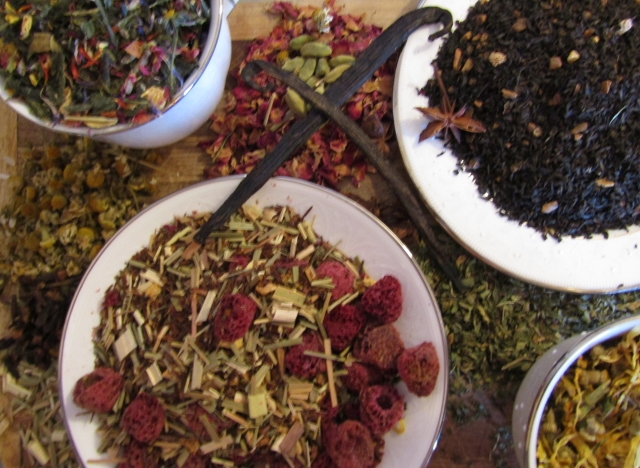Hand-crafted teas from the Tea Lady

Denise Short. Courtesy photo.
[May 5, 2022 | Montrose, Colo. |The Montrose Mirror |By Kathryn R. Burke]
SHE CALLS HER BUSINESS TEAS2PLEASE—the perfect name for her perfect teas. Denise Short combines natural and fresh ingredients, many locally-sourced, into scrumptious teas that are sure to please.
How…why…where did she get started? “It began with a tea garden at my home here in Montrose,” she explained. I’ve always liked tea, especially those that have natural (and unique) flavorings, and some that have also specific ingredients for medicinal purposes,” (like feverfew, which she grows to help with her chronic headaches). “I started growing herbs, mainly making teas for myself, experimenting with flavor profiles, then giving my teas to friends and family members.”
Meanwhile, Denise studied and read a lot about tea, learning about the different types—black, green, white, herbal; how they were made, what ingredients worked well together. “While I sat drinking my tea, I was also discovering interesting facts about teas,” she explained.
It’s the “pluck” that determines quality and cost of a tea. ‘First pluck’ usually refers to a delicate oolong, white tea which most comes from Japan or China. She also found out that in the Fujian Province of China, they once used trained monkeys to pick the tender first leaves of wild, ancient tea trees, that were out of reach of human hands!
Side Note: The name Monkey-picked Tea persists, but is it true? Sort of. Monkeys are trained to harvest other crops like coconuts and have certainly proven they have the intelligence and dexterity for these kinds of tasks. For those of us who don’t have extensive experience with training monkeys or picking tea, this seems like a fairly believable solution to an established problem. However, Tea leaves must be carefully handled to avoid bruising or breaking and tea harvesters must be able to differentiate and carefully select the proper leaves for the specific tea’s plucking standard, which often varies with the season…so it’s probably more legend than truth, but it’s a catchy name, isn’t it? (1)
More research proved that after water, tea is the most widely consumed beverage in the world. People have been drinking it for millennia, since at least 22,000 years ago…or before, dating back, perhaps, to the last ice age! Before they drank it, they ate it. People in ancient Asia would nibble on the raw leaves, add them to soups or greens to ferment, and chew like a betal nut (2)
Tea comes in various colors, grades, styles, and types, ranging from White Tea, through Oolong, Green Tea, Black Tea, Yellow Tea, combinations, Herbals, and Yerba Mate and Guayusa. Differentiation depends on where it is grown (climate, altitude, and terrain); when the leaves are plucked (white is first pluck); and how it is processed—the different levels of oxidation after leaves are plucked. Tea leaves will quickly wilt and oxidize unless immediately dried. The drying process also determines color. Leaves turn progressively darker as chlorophyll breaks down and tannins are released. Darkening (and mold growth) is stopped by heating. Reminds you a little of winemaking, doesn’t it.
Other differnetiaions depend on how it’s cut (hand-cut is the better grade); when and how it is “rolled” (spread out to dry); how it is processed (chopped, sprayed, rolled and cut), and how it is flavored—with combinations of leaves from various tea plants, for example, or made from herbs and other ingredients. Not all tea is made from tea leaves from a tea plant. Teas infused with fruit leaves, herbs and flowers are also called tisanes or herbal infusions. In some cases a tea, or tisane is (unfortunately) treated with (and flavored by) chemical additives.
Another thing to know, all tea, including caffeine-free tea contains caffeine, which constitutes about 3% of tea’s dry weight, and a lesser amount (but still present) is in de-caffeinated. Tea also contains small amounts of theobromine and theophylline, which are stimulants, and xanthines similar to caffeine. (3)
- Now that you know how tea is made, what styles and flavors it comes in, what does Denise do in producing her memorable, flavorable teas? Let’s start with how she sources them. “I had done a lot of research to find the right sources,” she said. “My tea leaves come from trusted companies that are established tea-growers. I wanted really good, quality teas.

“Next, I looked at companies where I could get the best quality herbs if I could not grow them myself in my tea garden. I wanted to go with more organic and wholesome.” She was able to cultivate different types of mint and roses, drying them for rose hips. She also found plenty of local sources for organic and seasonal fruit, which she dries at home.
“I grow pumpkin, then roast and dry it to put in my fall pumpkin chai tea,” she explained. She also grows green chilis for a fall tea. Green chilis? “Yes, and it’s really delicious,” she said. I also make a Champagne tea, which is kind of unsual, for my Morning Mimosa tea. I hand-spray . Rosé champagne on the tea when it’s rolled out for drying.
“For me, when I think about teas, I want people to have a memorable experience—what it smells like, looks like, texure as well as taste.”
Denise moved to Montrose from Montana, where she had a sub and ice cream shop that did really well, so she has a strong background in running a business. And in mixing things. “I’m really good at mixing different things together to come up with special combinations to get what I’m looking for, rather it’s teas, drinks, or food.”

Tea board, hand-crafting teas. Courtesy photo.
She makes her tea in small batches, carefully measures all the ingredients by the ounce, then puts it all together in a large bag.” Then, depending on what she wants, “I spray it, roll it up, mix it up in that bag.”
Her teas were so well-received by those she gave them to, that she took their advice and started her own tea business in 2020. “Right in the middle of Covid!” she noted. And it’s thriving. Today, working strictly by herself, Denise makes a variety of special teas, including the Morning Mimosa (described above), Serendipity Jasmine Oolong, a Green Maté Oolong, (“Maté is a south American plant that they substitute for their tea which is very high in caffine they drink that all the time”). I also do a nice Oolong, to drink by itself, and a combo of green and black tea.
Teas2Please specializes in seasonal teas. Here are the Spring Teas available now. Each has a special aroma, taste, and appearance. You won’t be able to resist trying them all.
“Spring Plum Fairy”- Just little sprinkle of fairy dust with dried plums and floral orange scent. “Spring Pear Bouquet”- Like a spring bouquet with the sweet taste of pear and zip of ginger. “Divinely Lemon” – Lemon, cool refreshing mint, and green tea creates a blend that is truly divine. “Bloomin Blossoms’” – Experience the grassy tones Sencha green tea mixed with apricot, mango, and subtle notes of floral. “Honeycomb Lavender” – Sweetness of honeycomb candy combined with black tea and Lavender. “Lady Londonderry” – A lovely spring tea with organic strawberries, delightful black tea with some floral notes
For those who don’t have ‘the works’ for steeping lose tea, Teas2Please also comes in tea bags. And if you aren’t sure what to get, take home a 6-variety Sample Pack.
You will find Denise Short and her Teas2Please at local Farmer’s Markets, where she has a booth in Ridgway (Fridays), Montrose (Saturdays), Palisade (Sunday) and at the Montrose Witch Shop (inside Flair) on Main Street in downtown Montrose.
Denise will also have a vendor table at Museum of the Mountain West 1st Annual Victorian Tea, May14th, where she is also providing the tea service for the event. Those lucky enough to hold a tea ticket will be charmed. If not, be sure to stop by her booth at Montrose Farmers Market or the Montrose Witch Shop inside Flair, Main Street, Montrose.
______-
Resources
(1) redblossomtea.com/blogs/red-blossom-blog/is-monkey-picked-tea-really-picked-by-monkeys
(2) & (3) en.wikipedia.org/wiki/Tea

